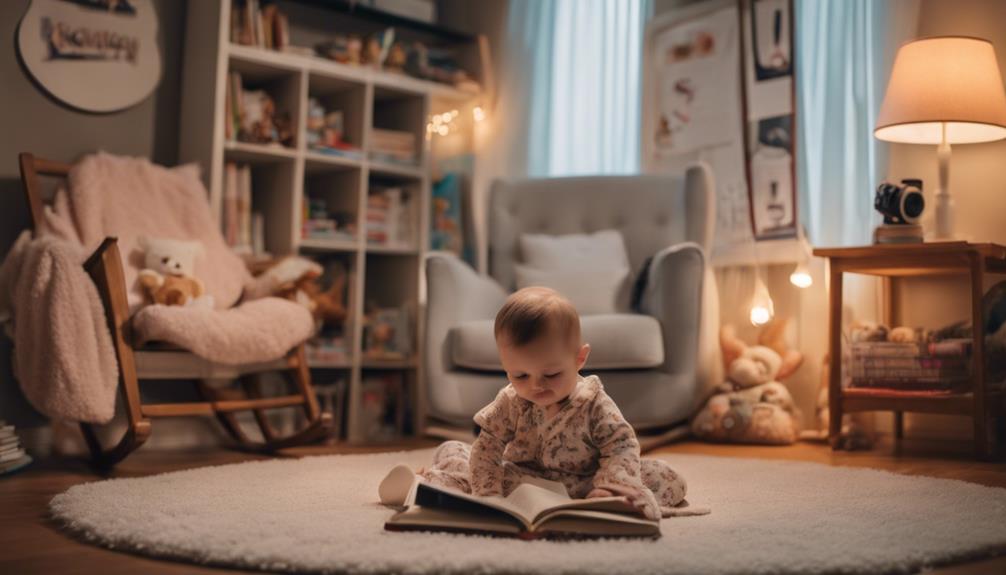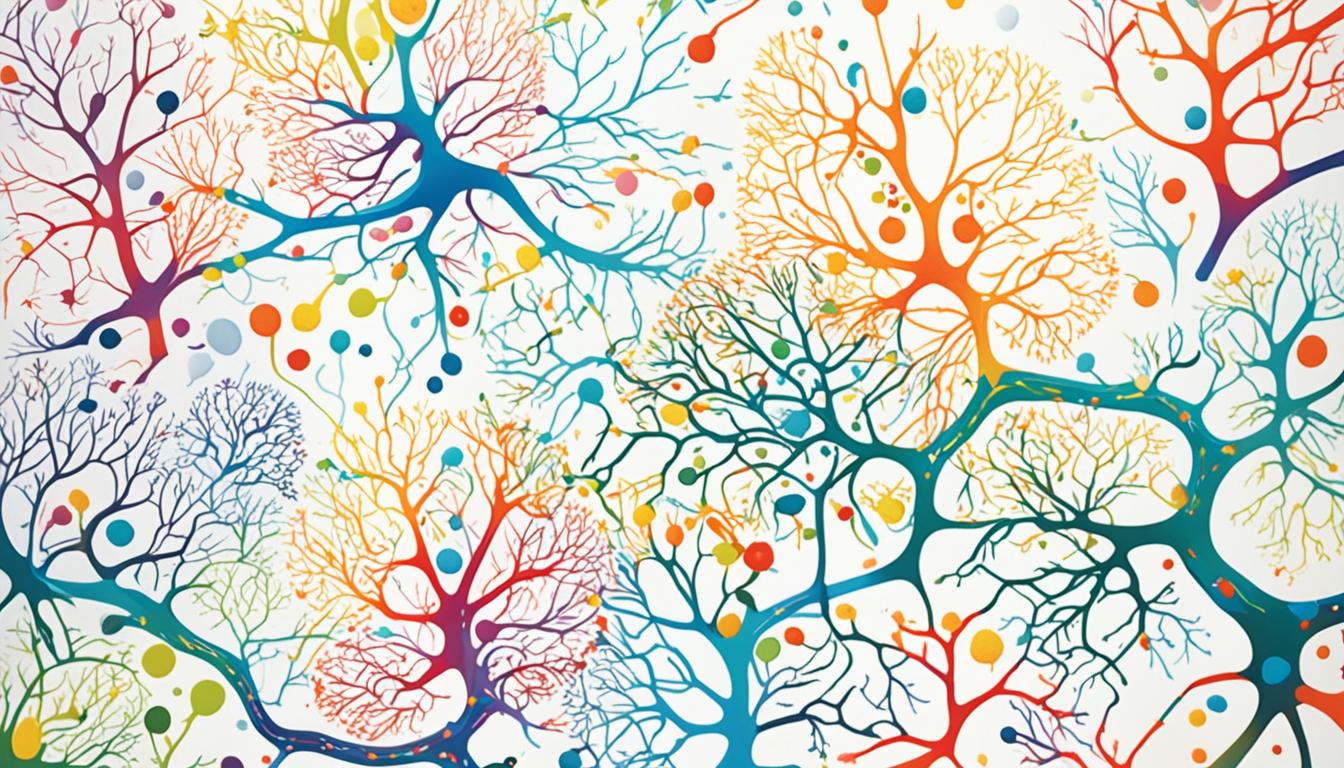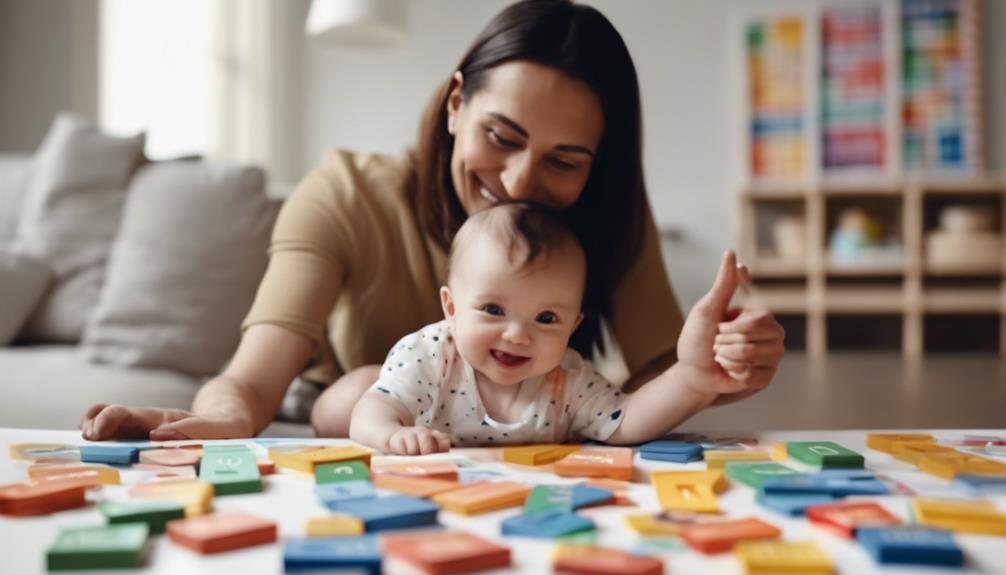Creating a peaceful environment by removing any disturbances and offering comfortable seating is crucial when reading to your baby before bedtime. Choose board books designed for babies and interactive books for older children to captivate your child with vibrant illustrations. Establishing a regular routine can encourage good sleep habits and improve emotional well-being. Keep in mind, bedtime stories can be a wonderful bonding experience that offers numerous benefits for both you and your baby. Further information is available for those who wish to delve deeper.
Key Takeaways
- Bedtime reading enhances parent-child bonding and aids in cognitive development.
- Choose age-appropriate books with vibrant illustrations for engagement.
- Set a soothing atmosphere with soft lighting and comfortable seating.
- Establish a consistent bedtime routine to promote better sleep.
- Use calming techniques like soft tones and interactive reading for a peaceful bedtime experience.
Benefits of Bedtime Reading
Essentially, bedtime reading to your baby offers numerous benefits that positively impact their development and well-being. Bedtime reading creates a special parent-child bonding time, fostering a strong emotional connection. This routine not only enhances language skills but also aids in cognitive development through exposure to new words and concepts. As you engage in bedtime reading, your baby's early literacy skills are being nurtured, laying a solid foundation for future academic success.
Moreover, bedtime stories have been shown to have a calming effect, helping babies relax and fall asleep more easily. By establishing a consistent bedtime routine that includes reading time, you aren't only promoting better sleep but also boosting your baby's attention span and problem-solving abilities.
Additionally, the social and emotional benefits of bedtime reading are significant, as it exposes your baby to different emotions and situations, fostering empathy and emotional intelligence. Essentially, incorporating bedtime reading into your nightly routine has a multitude of positive effects on your baby's overall development.
Age-Appropriate Book Selection

When selecting books for bedtime reading, take into account the age of your child to make sure the content is engaging and appropriate. Simple books with clear images are ideal for babies.
While toddlers may benefit from interactive choices that encourage participation. As children grow, introducing story-based books can enhance their understanding and enjoyment of reading.
Book Age Recommendations
For essential engagement and learning, selecting age-appropriate books is crucial when reading to children at bedtime.
When it comes to choosing books for different age groups, consider the following recommendations:
- Babies: Opt for board books with simple, big images to captivate their attention and promote visual recognition early on.
- Toddlers: Introduce repetitive and predictable books to enhance their understanding and keep them engaged during bedtime stories.
- School-Aged Children: Engage older children with chapter books that challenge their comprehension skills and spark their imagination.
Interactive Book Choices
During bedtime, engage your baby with interactive book choices that feature touch-and-feel elements, flaps, and textures to stimulate their senses and encourage participation in reading.
Choose age-appropriate books with big, colorful illustrations and simple text to captivate your baby's attention. Opt for interactive books like lift-the-flap or touch-and-feel books that allow your baby to explore and interact while you read to them.
Select board books with sturdy pages that can endure your baby's handling during bedtime reading sessions. Look for books with engaging features such as sound effects or interactive elements that prompt your baby to participate actively in the reading experience.
Consider books with repetitive patterns, rhymes, and vibrant illustrations to keep your baby engaged and entertained during bedtime.
Setting the Right Atmosphere

To set the right atmosphere for bedtime reading, make sure the room is calm and cozy, with soft lighting choices that promote relaxation and signal bedtime.
Creating a soothing environment can help your baby wind down and prepare for sleep, enhancing the bedtime routine experience for both of you.
Calm Room Environment
Create a serene environment by guaranteeing distractions are eliminated and incorporating elements like soft lighting and cozy seating for ideal bedtime reading to your baby.
To set the right atmosphere, consider the following:
- Distractions: Make sure the room is free of loud noises and bright lights to help your baby focus on the bedtime reading session.
- Comfortable Seating: Providing a cozy and comfortable seating arrangement for you and your baby can enhance the bedtime reading experience.
- Consistent Bedtime Routine: Establishing a consistent bedtime routine, including reading at the same time each night, can help create a calming association with sleep.
Soft Lighting Choices
Eliminating distractions and ensuring a calm room environment can be complemented by selecting soft lighting choices that create a soothing atmosphere for bedtime reading to your baby. Soft lighting, such as dim lamps or nightlights, contributes to a cozy atmosphere that's vital for your little one.
This type of lighting helps regulate melatonin production, which is essential for the natural sleep-wake cycle. By opting for soft lighting, you can signal to your baby that it's time to unwind and prepare for sleep, enhancing the overall soothing experience of reading to them at bedtime.
Avoiding harsh overhead lighting is essential as it can be too stimulating and hinder the winding down process before sleep. Remember, creating a peaceful environment with soft lighting is key to setting the right mood for bedtime reading with your baby.
Reading Techniques for Baby

When reading bedtime stories to your baby, maintain a soft and slow tone to create a calming atmosphere conducive to relaxation before sleep. Consider the cadence of your voice to promote a soothing environment that helps your little one wind down effectively.
To enhance the experience for your baby, here are some essential reading techniques:
- Choose age-appropriate books with colorful illustrations and simple stories to engage your child's interest and imagination.
- Create a warm and engaging environment by cuddling with your baby during bedtime story sessions, fostering a sense of security and closeness.
- Be intentional with how you read, focusing on creating an interactive and enjoyable experience for your baby, ensuring that the bedtime stories become a cherished part of your nightly routine.
Establishing a Routine

To establish a bedtime reading routine for your baby, consider incorporating consistent reading sessions into your nightly schedule between 6.30pm and 8.30pm. This routine can aid in creating a vital atmosphere, helping your baby wind down before sleep. According to experts, bedtime reading can assist in improving the quality and duration of your baby's sleep.
By engaging in regular reading sessions at bedtime, you can reduce resistance to sleep and foster healthy sleep habits for your little one.
Establishing a routine is essential for babies as it provides a sense of predictability and security. Reading to your baby at bedtime avoids the exposure to blue light from screens, which can disrupt sleep patterns. Experts suggest that bedtime reading routines between 6.30pm and 8.30pm can significantly contribute to helping babies establish healthy sleep patterns.
Bedtime Reading Tips

Consider incorporating a soft and slow tone while reading bedtime stories to engage your baby's interest and maintain a calming bedtime routine.
To enhance your bedtime reading experience, follow these tips:
- Choose age-appropriate books: Select books with big images and simple storylines to keep your child engaged and interested.
- Embrace repetition: Young children benefit from repetition, so don't hesitate to read the same bedtime stories multiple times to create a sense of familiarity and comfort.
- Set clear expectations: Communicate clear boundaries and limits on the number of books to foster a calming atmosphere and signal that it's time for sleep.
Importance of Consistency

Additionally, considerably maintaining consistency in bedtime reading routines can greatly benefit your baby's overall well-being and sleep quality. By establishing a regular schedule for bedtime stories, you provide your baby with a sense of routine and predictability. This predictability helps in soothing and preparing your little one for sleep, reducing anxiety, and promoting relaxation. According to experts, a consistent bedtime reading routine can greatly improve your baby's sleep quality and duration, leading to better overall rest.
Babies thrive on predictability, and a steady bedtime reading schedule contributes to their emotional well-being and stability. Additionally, this routine not only enhances sleep patterns but also strengthens the parent-child bond through shared, calming experiences. By incorporating bedtime stories into a consistent nightly routine, you aren't merely reading a story but also fostering a sense of stability and security for your baby.
Encouraging Engagement

Enhance your baby's bedtime reading experience by actively engaging them through expressive sounds and interactive elements. To foster engagement during bedtime stories, consider the following:
- Utilize expressive sounds:
- Incorporate different voices.
- Imitate animal sounds.
- Use sound effects to capture your baby's attention and make the story come alive.
- Encourage participation:
- Ask questions.
- Point to pictures.
- Involve your baby in the storytelling process to keep them engaged and interested in the narrative.
- Create a calming atmosphere:
- Read with soft tones.
- Use a gentle cadence.
- Provide a sense of closeness to establish a peaceful environment that promotes engagement and relaxation.
Troubleshooting Challenges

To address challenges that may arise during bedtime reading with your baby, focus on troubleshooting strategies that can help maintain a peaceful and engaging experience.
When selecting bedtime stories, opt for calming tales with soothing tones to prevent overstimulation. Engaging your child in book selection can combat resistance and enhance involvement in the reading process.
Create a quiet and cozy environment to minimize distractions and promote focused reading time. Setting clear expectations and boundaries for reading at bedtime can help manage disruptions to the routine.
Establishing a consistent bedtime reading schedule is vital in reinforcing the habit and overcoming inconsistency. Remember, 'Consistency is key when it comes to bedtime routines,' as noted by child development experts.
Frequently Asked Questions
Should You Read to a Baby Before Bed?
You should definitely read to a baby before bed. It helps with bonding, relaxation, language skills, and positive sleep associations. Reading bedtime stories can create a calming routine and strengthen your relationship with your little one.
Should You Read to Your Child Before Bed?
You should read to your child before bed. It enhances bonding, boosts cognitive development, and promotes better sleep. Did you know that children who are read to regularly score higher on literacy tests? Make bedtime stories a routine!
Is Reading Before Bed Recommended?
Yes, reading before bed is highly recommended. It helps create a calming routine, promotes bonding, and enhances literacy skills. Make it a habit between 6.30pm and 8.30pm for maximum benefits, fostering love and positive interactions.
When Can You Start Reading Bedtime Stories to Babies?
Isn't it obvious? You can start reading bedtime stories to babies right from the get-go. It's never too early to introduce them to the magic of storytelling and create special bonding moments.
Conclusion
To sum up, bedtime reading to your baby has numerous benefits that can positively impact their development. By selecting age-appropriate books, setting the right atmosphere, and using effective reading techniques, you can create a routine that promotes engagement and relaxation.
Remember, consistency is key in establishing this comforting habit. As Albert Einstein once said, 'If you want your children to be intelligent, read them fairy tales. If you want them to be more intelligent, read them more fairy tales.'
So, start reading to your baby tonight and watch the magic unfold.










